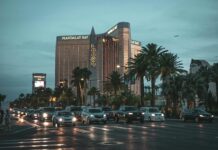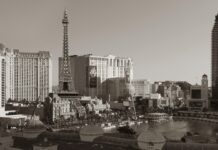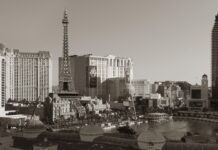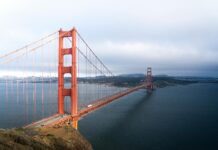The Las Vegas Shooting Map reveals shocking details and insights that many people have never seen before. If you’re looking to understand the tragic event from October 1, 2017, in a way that goes beyond headlines, this article is your must-read guide. What exactly happened that night? Where did the shooter position himself, and how did the chaos unfold across the city? By diving deep into the Las Vegas shooting map, we uncover crucial information that sheds light on the timeline and geography of the incident.
This detailed Las Vegas shooting map analysis not only highlights the locations targeted but also explains the broader implications for public safety and law enforcement response. You might be wondering, “How can a simple map provide such powerful insights?” Well, this interactive and comprehensive map helps visualize the tragic moments and the sequence of events, making it easier to grasp the complexity of what unfolded on that fateful night. Whether you are a researcher, journalist, or someone personally affected by the tragedy, the map’s details will give you a new perspective.
Moreover, the Las Vegas shooting map connects to trending topics like gun control debates, emergency preparedness, and urban security measures. What can we learn from this map about preventing future tragedies? How did the geography of the event impact the rescue efforts? Stay tuned as we uncover these questions and more with a deep dive into the most revealing Las Vegas shooting map insights available online. Don’t miss out on these eye-opening details that everyone should know.
Detailed Las Vegas Shooting Map: Explore the Exact Locations and Timeline of the Tragic Event
The tragic Las Vegas shooting in 2017 remains one of the deadliest mass shootings in American history. Many people want to understand more about where exactly the event happened, the timeline of the shooting, and the broader impact it had on the city and beyond. A detailed Las Vegas shooting map provides a powerful way to explore these facts, showing the exact locations, sequence of events, and how everything unfolded during those horrific moments. This article will dive into the details of the shooting map, uncover shocking insights, and help readers grasp the full scope of this tragedy.
What Is the Las Vegas Shooting Map?
The Las Vegas shooting map is a visual and informational tool that outlines the precise locations involved in the October 1, 2017 shooting at the Route 91 Harvest music festival. This map shows where the shooter was positioned, the paths law enforcement took, emergency response locations, and where victims were found. It provides context that simple descriptions or news reports can’t fully convey.
The shooting took place from the 32nd floor of the Mandalay Bay Resort and Casino. From there, the gunman fired into a crowd attending the country music festival on the Las Vegas Strip. Using a map helps trace how the bullets traveled, where casualties occurred, and how responders moved to contain the situation.
Key Locations Highlighted in the Las Vegas Shooting Map
- Mandalay Bay Resort (32nd Floor, Room 135): This was the shooter’s position, where he opened fire with multiple firearms.
- Route 91 Harvest Festival Grounds: The open-air venue where thousands gathered, and the majority of victims were located.
- Medical Triage Areas: Temporary medical stations set up near the festival to treat the injured.
- Law Enforcement Staging Areas: Points where police and SWAT teams assembled before moving to engage the shooter.
- Evacuation Routes: Paths used to help attendees escape from the area safely.
By marking these places, the map reveals how complex the scene was, and how emergency responders had to coordinate under extreme pressure.
Timeline of the Shooting: Minutes That Changed Everything
Understanding the timeline is critical to grasp the scale and rapidity of the events. Here’s an outline of the key moments:
- 10:05 PM: Gunfire begins from the Mandalay Bay 32nd floor.
- 10:06 – 10:15 PM: Multiple shots fired rapidly toward the crowd.
- 10:15 PM: First emergency calls made by festival attendees.
- 10:17 PM: Police receive reports and begin mobilizing.
- 10:20 PM: SWAT teams enter Mandalay Bay to locate the shooter.
- 10:30 PM: Shooter is found deceased in the hotel room.
- 10:45 PM and onward: Medical evacuation and law enforcement secure the area.
This timeline helps to understand how quickly the situation escalated and how law enforcement reacted in real time.
Shocking Details and Insights Uncovered by the Map
The shooting map uncovers several unsettling facts:
- The shooter had a clear line of sight over a large crowd, maximizing casualties.
- Multiple vantage points were identified where victims were hit, showing the widespread area affected.
- Emergency services had to navigate crowded and chaotic spaces, complicating rescue efforts.
- The use of hotel corridors and elevators by the shooter was mapped out, showing premeditation.
- Evacuation routes had to be quickly adapted due to congestion and panic.
These insights highlight the complexity and horror faced by everyone involved.
Comparison with Other Shooting Incident Maps
Looking at other mass shooting maps, like those from Columbine, Sandy Hook, or Parkland, the Las Vegas shooting stands out due to:
- The elevated sniper-style shooting from a high-rise hotel.
- The exceptionally large crowd size (around 22,000 attendees).
- The duration of the shooting, which lasted over 10 minutes, longer than most.
- The vast open area of the festival grounds compared to enclosed school or building environments.
These factors made the Las Vegas shooting uniquely devastating and challenging for emergency responders.
Practical Applications of the Las Vegas Shooting Map
Beyond documenting the tragedy, the shooting map serves several practical purposes:
- Law Enforcement Training: Helps officers study response strategies and improve for future incidents.
- Public Awareness: Educates the community about the event’s scale and safety planning.
- Emergency Preparedness: Assists event organizers in designing safer venues and evacuation plans.
- Victim Support: Aids in identifying locations where survivors and witnesses were present for trauma counseling.
The map is not just a record but a tool for learning and prevention.
What the Map Shows About Crowd Dynamics and Safety
Festival crowds are typically large and tightly packed, which unfortunately increases vulnerability during active shootings. The Las Vegas shooting map demonstrates:
- How crowd density affected movement and escape.
- The bottlene
How the Las Vegas Shooting Map Reveals Shocking Patterns and Critical Safety Insights
The tragic Las Vegas shooting in 2017 remains one of the deadliest mass shootings in modern U.S. history. While many remember the event for its immediate horror, analyzing the Las Vegas shooting map reveals shocking patterns and critical safety insights that could help prevent future tragedies. The map, which plots the exact locations and movements during the shooting, provides a grim but necessary look into how the event unfolded and where vulnerabilities existed.
What the Las Vegas Shooting Map Shows
A Las Vegas shooting map is more than just dots on a map. It shows the sniper’s position, the flow of people trying to escape, emergency responders’ routes, and even the areas where victims were found. From this, patterns start to emerge that were not obvious in the chaotic moments of that night.
For example, the shooter positioned himself on the 32nd floor of the Mandalay Bay Resort. The map reveals the line of sight he had over the crowd at the Route 91 Harvest music festival, which was directly across the street. It shows how the open layout of the festival grounds allowed bullets to travel freely, hitting large groups of people. This insight points to the importance of assessing sightlines in outdoor events.
Historical Context and Comparison to Other Shootings
Looking back at other mass shootings, like the Pulse nightclub shooting in Orlando or the Sandy Hook Elementary tragedy, maps have often provided crucial information about shooter’s movements and escape routes. Unlike those incidents, the Las Vegas shooting map shows a unique sniper-style attack from a distance, rather than close-quarter engagement.
This comparison highlights how different shooting scenarios require different safety protocols. For instance:
- Close-quarter attacks need rapid evacuation procedures and secure exits.
- Long-range sniper attacks demand perimeter security and surveillance.
The Las Vegas shooting map underlines that security measures can’t be one-size-fits-all.
Critical Safety Insights from the Map
Studying the Las Vegas shooting map reveals multiple safety lessons. Here are some of the key takeaways:
- Elevated Positions Are High Risk: The shooter’s high vantage point gave him a deadly advantage. Event planners must consider how nearby buildings or structures could be used in attacks.
- Crowd Density Matters: The festival’s packed audience was a vulnerable target. Managing crowd density and having multiple escape options can reduce casualties.
- Emergency Response Routes: The map showed some responders had difficulty reaching victims quickly because of barricades or crowd congestion. Clear, unobstructed emergency paths are essential.
- Communication Breakdowns: The chaos visible on the map also reflects communication failures between security and medical teams. Efficient communication networks are crucial during crises.
How Organizers Can Use These Insights
Event organizers in Las Vegas and elsewhere can apply lessons from the shooting map to improve safety. Some practical examples include:
- Site Planning: Before any large event, organizers should map out potential sniper positions or places from where attackers could strike from a distance.
- Crowd Management: Implementing controlled entry points and dispersed seating or standing areas can make it harder for a shooter to target many people.
- Emergency Drills: Regularly practicing evacuation and medical response drills helps prepare staff for real emergencies.
- Technology Integration: Using drones, cameras, and other surveillance tools to monitor elevated areas around event venues.
A Simple Table of Patterns and Insights
| Pattern Observed | Safety Insight | Practical Action |
|---|---|---|
| Shooter’s elevated position | Vulnerability of high floors | Secure or monitor high vantage points |
| Dense crowd areas | Increased target size | Disperse crowds, multiple exits |
| Blocked emergency routes | Delayed medical response | Clear, marked emergency paths |
| Communication gaps | Confusion during crisis | Establish reliable communication |
Uncovering Shocking Details Through the Map
Beyond general safety, the map reveals some disturbing details about how quickly the situation escalated and how many lives were affected in seconds. It shows the radius of the shooting impact, stretching beyond the immediate festival grounds as people fled in all directions, some getting trapped in nearby streets or parking lots.
Survivors’ interviews, combined with the map data, indicate many were unaware of the shooter’s location at first because he was so far away. This delay in awareness made early warning systems even more critical. The map, therefore, highlights the need for rapid alert mechanisms to inform large crowds instantly of danger.
Comparing Las Vegas to Other Cities
When looking at shooting maps from other cities, Las Vegas stands out because of its urban layout and event type. The open-air concert setting is unique compared to shootings in confined indoor spaces. For example:
- Orlando’s Pulse nightclub shooting involved a single enclosed building.
- Sandy Hook was in a school with multiple rooms and hallways.
Las Vegas’s scenario requires different safety technologies, such as perimeter security and crowd dispersion strategies, which are less emphasized in indoor settings
Top 5 Key Areas Highlighted in the Las Vegas Shooting Map You Need to Know About
The tragic event that shook Las Vegas in October 2017 still haunts many people today, but the Las Vegas shooting map has brought to light some key areas of interest that many dont fully understand. This map isn’t just a simple layout; it reveals shocking details and insights about where the shooting happened and how it unfolded. Anyone trying to grasp the full scope of the incident should know these top 5 key areas highlighted in the Las Vegas shooting map. These spots provide context, historical data, and practical understanding for residents and visitors alike.
1. The Mandalay Bay Hotel – The Shooter’s Location
First and foremost, the Mandalay Bay Hotel is the most critical area marked on the Las Vegas shooting map. This is where the gunman set up and opened fire on the crowd attending the Route 91 Harvest music festival below. The shooter was positioned on the 32nd floor, giving him a wide vantage point to target thousands of people.
- The hotel room was meticulously chosen for its panoramic outlook.
- The shooter brought multiple firearms and ammunition across several suitcases.
- Security measures in the hotel failed to detect the suspect’s preparation.
Understanding the Mandalay Bay Hotel’s layout is crucial because it explains the shooting angles and the difficulty law enforcement had in quickly stopping the attack. The map shows nearby exits and stairwells which were used during the emergency response efforts.
2. Route 91 Harvest Festival Grounds – The Target Zone
The festival grounds is the second major area on the map. This was the location where the concert was taking place and where the most casualties happened. The open-air venue had thousands of attendees packed closely, making them vulnerable to the gunshots from above.
Key points about the festival grounds include:
- The stage location relative to the hotel’s shooting position.
- Crowd density and emergency evacuation routes.
- Medical tents and first responder stations.
The Las Vegas shooting map highlights how the festival’s layout contributed to both the scale of the tragedy and the complexity of the rescue operations. It also helps explain why some areas were more heavily affected than others.
3. Law Enforcement Response Points
One of the less talked about but very important features on the Las Vegas shooting map are the law enforcement response points. These are places where police and SWAT teams staged their operations and coordinated their reaction to the shooting.
These points include:
- The hotel lobby entrance and security checkpoints.
- Nearby streets that were used for staging tactical units.
- Emergency medical centers set up close to the scene.
This area shows how quickly and efficiently first responders acted under extreme pressure. The map indicates which routes were blocked off and how officers managed to breach the shooter’s room after about an hour of firing. It paints a picture of the chaos and heroism that unfolded during those critical moments.
4. Nearby Hotels and Properties Affected
The shooting didn’t only impact Mandalay Bay and the festival grounds. The Las Vegas shooting map also marks several adjacent hotels and properties that were either indirectly affected or became part of the evacuation process.
Some notable facts about these locations:
- Hotels like the Luxor and Excalibur had to be locked down for safety.
- Evacuation routes for guests and staff were planned quickly.
- Traffic congestion and road closures extended several blocks away.
This part of the map helps to understand the wider impact of the tragedy on the Las Vegas Strip as a whole, not just the immediate shooting zone. It also gives perspective on how emergency services managed a large-scale crisis in a bustling tourist area.
5. Medical and Trauma Centers Used for Victims
Finally, the Las Vegas shooting map identifies hospitals and trauma centers that treated the injured. This key area reveals how the city’s healthcare system responded to one of the worst mass shootings in U.S. history.
Important elements include:
- Hospitals like Sunrise Hospital and Medical Center received the majority of victims.
- Ambulance routes and trauma triage locations.
- Coordination between multiple medical facilities across the city.
Listing these medical centers emphasizes the scale of the emergency response and the challenges faced by healthcare professionals. It also highlights the preparedness of Las Vegas medical infrastructure for handling mass casualty events.
Summary Table of the Top 5 Key Areas
| Area | Description | Importance |
|---|---|---|
| Mandalay Bay Hotel | Shooter’s location, 32nd floor room | Origin of attack, vantage point |
| Route 91 Harvest Festival | Concert grounds, main victim area | Target zone, crowd density |
| Law Enforcement Response | Police staging and tactical points | Coordination and breach efforts |
| Nearby Hotels and Properties | Adjacent hotels affected or evacuated | Wider impact, evacuation routes |
| Medical and Trauma Centers | Hospitals and emergency treatment sites | Victim care, medical response |
This table sums up the crucial locations that anyone looking at the Las Vegas shooting map should know. Each area tells a part of the bigger story and helps uncover shocking details
What the Las Vegas Shooting Map Tells Us About Crowd Movement and Emergency Response
The tragic Las Vegas shooting in October 2017 left a scar on the city and the nation. While many remember the event for its horrifying magnitude, the Las Vegas shooting map reveals much more about how crowds move and how emergency responders acted during the chaos. This map, often overlooked in news reports, uncovers shocking details and insights that help us understand what happened on that dreadful night and what could improve future responses to mass emergencies.
What the Las Vegas Shooting Map Shows About Crowd Movement
The shooting took place from the 32nd floor of the Mandalay Bay Resort, targeting a crowd attending the Route 91 Harvest music festival. The map of the event area and the shooting locations tell us about the unpredictable nature of crowd movement during a crisis.
- Most attendees were gathered in a large, open outdoor space facing the stage.
- The shooting started suddenly, causing immediate panic and chaos.
- People fled in multiple directions, often ignoring designated exits.
- Bottlenecks appeared where pathways narrowed, causing dangerous crowding.
- Some fled toward the nearby streets, while others sought shelter behind structures or vehicles.
This chaotic dispersal pattern highlights how people behave when faced with sudden danger. Instead of orderly evacuation, fear triggers a mass rush that can increase injury risks. The map shows clusters of people trapped in confined spaces, which emergency planners must consider in future event designs.
Emergency Response Revealed by the Las Vegas Shooting Map
The map not only tracks the victims and the shooter’s location but also the movements of police, medical personnel, and bystanders who tried to help. This reveals strengths and weaknesses in the emergency response system.
- Police arrived at the scene within minutes but faced challenges reaching the shooter due to limited access routes.
- Medical teams had to set up triage areas far from the shooting site because the crowd made it impossible to get close.
- Communication breakdowns occurred between different emergency units, slowing coordinated efforts.
- Bystanders provided first aid before professionals arrived, demonstrating the importance of public training in emergencies.
- The map shows areas where responders could not reach quickly due to crowd density or physical barriers.
The shooting map’s details illustrate the complexity of managing a mass casualty incident in a crowded and confined environment. It points out that emergency plans must consider not just the shooter’s location but also how crowds move and where responders can safely operate.
Historical Context: Why the Las Vegas Shooting Map Matters
Before Las Vegas, mass shooting incidents in the US had different crowd dynamics. For example:
- The 2016 Orlando nightclub shooting involved an enclosed indoor space with fewer escape routes.
- The 2015 Charleston church shooting happened in a small, contained community.
- The 2012 Aurora theater shooting had some similarities but fewer people outdoors.
Las Vegas was the deadliest mass shooting in modern US history, partly because it happened in a large outdoor venue with tens of thousands of people. The shooting map helps law enforcement and event organizers learn from this unprecedented situation.
By comparing maps from past incidents, experts see patterns in how people react and where emergency efforts succeed or fail. The Vegas map is a vital tool in improving security measures and medical response plans for large outdoor events worldwide.
Key Insights from the Las Vegas Shooting Map
Here are some crucial takeaways based on the detailed shooting map analysis:
Escape Routes Need Clear Marking and Widening
Many bottlenecks emerged due to narrow exits and unclear signage. Future venues must design multiple wide escape routes to prevent crowd crushes.Emergency Access Must Be Maintained at All Times
The shooter’s vantage point was difficult to reach, delaying police intervention. Emergency lanes and access points must be planned around large venues.Communication Systems Between Agencies Need Upgrading
The map shows delays caused by poor communication. Integrating radio and digital communication systems among police, fire, and medical services is vital.Public Training Saves Lives
Numerous victims survived because bystanders administered first aid. Promoting crowd training in emergency response can drastically reduce fatalities.Real-Time Crowd Monitoring Could Help
Using drones or sensors to monitor crowd density and movement can alert organizers to dangerous buildups or blocked exits during emergencies.
Practical Examples of How the Map Can Influence Future Events
- Festival organizers in Las Vegas and elsewhere can use map data to redesign stages, vendor areas, and emergency paths.
- Police departments might simulate responses using actual crowd movement patterns from the map to train officers better.
- Medical teams can plan triage stations based on areas identified as accessible and safe on the map.
- City planners can review zoning and traffic flow around large venues to ensure emergency vehicles can arrive quickly.
- Event goers could be better informed about exit locations and emergency procedures using maps distributed before events.
Comparison Table: Crowd Movement vs Emergency Response Challenges
| Aspect | Crowd Movement Observations | Emergency Response Challenges |
|—————————-|———————————————-
Unveiling Hidden Facts: Interactive Las Vegas Shooting Map Analysis for Public Awareness
Unveiling Hidden Facts: Interactive Las Vegas Shooting Map Analysis for Public Awareness
The tragic event that shook Las Vegas on October 1, 2017, remains one of the deadliest mass shootings in modern American history. While the raw numbers and headlines captured the world’s attention, many details remain overlooked by the general public. One tool that has gained attention is the interactive Las Vegas shooting map, which helps uncover shocking details and insights that traditional news reports might miss. This article explores the las vegas shooting map and how it contributes to public understanding of what really happened that night.
What is the Las Vegas Shooting Map?
The las vegas shooting map is a digital, interactive tool that plots the locations of shots fired, victims, police responses, and other critical points related to the event. Unlike static images or written reports, this map allows users to zoom in and out, see the sequence of events unfold geographically, and explore the scene in a more detailed way. It’s not just about where the shooting took place—it’s about how the shape of the event impacts individuals and the community.
This kind of mapping is important because it reveals patterns and data points hidden within complex incidents. For example, it shows the exact spots where bullets hit, the proximity of victims to the shooter’s location, and the timings of emergency responses. These insights helps researchers, law enforcement, and policymakers learn from the tragedy.
Historical Context Behind the Shooting
The massacre happened during the Route 91 Harvest music festival held on the Las Vegas Strip. Stephen Paddock, the shooter, opened fire from the 32nd floor of the Mandalay Bay hotel, targeting an audience of over 22,000 concertgoers. The attack lasted approximately 10 minutes and resulted in 60 deaths and over 850 injuries.
Mapping the event geographically highlights how densely packed the crowd was and how the shooter’s high vantage point gave him a disturbing advantage. It also shows the challenging terrain first responders had to navigate through to reach victims.
Key Insights from the Interactive Map
Many findings from the Las Vegas shooting map analysis are shocking and sometimes difficult to comprehend. Here are some of the most important ones:
- The shooter fired more than 1,100 rounds during the attack.
- Bullets traveled over 400 yards, crossing busy streets and hitting multiple locations.
- Victims were spread out in a wide radius, not just concentrated in one area.
- Emergency response times varied widely, with some victims receiving aid much faster than others.
- The angle of fire and bullet trajectories indicate the shooter’s calculated planning.
This data not only informs about the incident itself but also shines light on possible improvements in event security and emergency protocols.
How Does the Map Help in Public Awareness?
Using an interactive map makes the tragedy more tangible for the public. Seeing the shooting unfold on a map lets people grasp how chaotic and widespread the event was. It also helps dispel myths and rumors by providing factual, location-based evidence.
For example, some thought the shooting was concentrated in one spot, but the map shows otherwise. It also helps survivors and relatives understand the broader context of what happened around them, which can be important for healing.
Practical Examples of Map Utilization
Several groups have used the las vegas shooting map to improve future safety measures or conduct research. Some examples include:
- Law enforcement agencies analyzing the shooter’s movements and response times to optimize future emergency responses.
- Event organizers studying crowd layouts and sightlines to increase safety at large gatherings.
- Mental health professionals using victim location data to better understand trauma exposure.
- Media outlets employing the map to create more accurate and responsible reporting.
These practical uses demonstrate that the map is more than just a visual tool—it’s a resource for learning and prevention.
Comparison: Las Vegas Shooting Map vs Other Incident Maps
When comparing the las vegas shooting map with other mass shooting maps, some unique features stand out:
| Feature | Las Vegas Shooting Map | Other Mass Shooting Maps |
|---|---|---|
| Scale of Incident | Extremely large, thousands affected | Smaller scale, fewer victims |
| Shooter Location | High vantage point (hotel floor) | Often ground level or indoor |
| Duration | Approximately 10 minutes | Typically shorter, under 5 minutes |
| Data Detail | Bullet trajectories, victim spread | Usually basic locations only |
| Public Accessibility | Interactive and detailed | Often static or limited |
This comparison highlights the complexity of the Las Vegas event and why a detailed map is particularly useful.
What Can We Learn Moving Forward?
The interactive las vegas shooting map analysis is a reminder that understanding tragedies requires more than just numbers. It needs geographic context, timing, and detailed data about the environment. Only through this multifaceted view can communities, authorities, and individuals prepare better for the future.
From improving safety designs at mass events, to refining emergency responses, the lessons learned from the map can save
Conclusion
In conclusion, the Las Vegas shooting map serves as a crucial tool for understanding the tragic events that unfolded during one of the deadliest mass shootings in U.S. history. By examining the detailed layout of the Mandalay Bay Resort and the surrounding areas, the map provides valuable insights into the shooter’s vantage points, escape routes, and the locations of victims. This visual representation not only aids law enforcement and researchers in analyzing the incident but also helps the public grasp the scale and impact of the tragedy. Awareness and education through such resources are vital in fostering community preparedness and supporting ongoing efforts to prevent future incidents. As we reflect on this somber event, it is important to advocate for enhanced safety measures and to support victims and their families. Staying informed and engaged is a step toward building safer environments for all.











